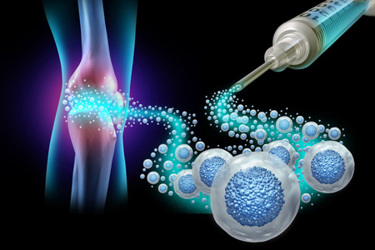Mesenchymal Stem Cells Hold The Key To Treating Degenerative Conditions
By Edward Ahn, CEO, MEDIPOST Inc.

People aren’t just living longer — they’re striving to live better. As global life expectancy continues to increase, the demand for therapies that enhance mobility, reduce chronic pain, and improve overall vitality grows stronger. Mesenchymal stem cells (MSCs) offer a promising path forward in managing complex conditions that are often age-related — a welcome alternative to traditional treatments like symptom management or invasive surgery.
The Growing Burden Of Degenerative Conditions
With the proportion of the world’s population over 60 years in age expected to nearly double from 2015 to 2050, degenerative conditions, many of which have age as a primary risk factor, are becoming an increasingly urgent public health challenge. Osteoarthritis alone affects over 32.5 million U.S. adults. However, joint health is just the tip of the iceberg.
Degenerative processes affect nearly every system in the body, driving conditions such as Alzheimer’s, Parkinson’s, cardiovascular disease, diabetic complications, chronic lung diseases, and impaired wound healing — all of which diminish quality of life and strain healthcare systems.
Despite their differences, these conditions share common underlying mechanisms: chronic inflammation, oxidative stress, and impaired tissue repair. Early-stage interventions typically rely on medication to mask symptoms rather than addressing the underlying causes. When conditions progress, surgical options — such as joint replacements — become the standard, though they come with inherent risks and long recovery times.
There’s a growing need for therapies that help maintain function and vitality without drastic interventions. Mesenchymal stem cells offer one such approach, targeting the biological mechanisms behind degeneration and inflammation before more invasive measures are necessary.
What Makes Mesenchymal Stem Cells Unique?
Mesenchymal stem cells stand out due to their multifunctional properties. Unlike therapies that target a single aspect of a condition, MSCs operate on multiple fronts:
- Anti-inflammatory: MSCs help reduce chronic inflammation, a key driver of many degenerative conditions. Chronic inflammation contributes to pain, accelerates tissue degradation, and can exacerbate other age-related diseases.
- Anti-catabolic: MSCs inhibit enzymes that break down tissue, slowing the progression of degeneration. This function is crucial for conditions like osteoarthritis, where cartilage degradation outpaces the body’s ability to repair it.
- Pro-anabolic: MSCs stimulate the body’s natural repair processes, encouraging faster and more comprehensive tissue regeneration.
What sets MSCs apart is that they don’t need to differentiate into specific cell types to exert these effects. Instead, they influence the body through the secretion of cytokines and growth factors, interacting dynamically with the local microenvironment. This capability allows MSCs to respond to the body’s needs based on the specific conditions of an individual patient — whether reducing inflammation, slowing tissue breakdown, or promoting repair.
Additionally, MSCs’ immune-privileged status means they pose a low risk of rejection when transplanted. This feature makes them suitable for allogeneic use (from donor to recipient), broadening their potential applications and simplifying treatment logistics.
The Challenge: Gaining Clinical Ground
Mesenchymal stem cells have been slower to establish a strong clinical presence compared to other cell therapies. Treatments like T-cell therapies for bloodborne cancers have demonstrated profound, curative outcomes — effectively eradicating certain malignancies. Similarly, gene therapies like Zolgensma have transformed the prognosis for monogenetic diseases such as spinal muscular atrophy, allowing children to live well beyond what was previously possible.
While MSCs have not yet produced similarly dramatic, curative results, they do offer significant benefits in the management of chronic, degenerative conditions. Their strength lies in improving quality of life and maintaining functional health over the long term. The focus on moderating inflammation and supporting tissue health positions MSCs as an ideal therapy for degenerative, age-related conditions, where the goal is often to slow progression and maintain mobility rather than provide a definitive cure.
This distinction reflects a broader shift in how we think about healthcare. In many Western medical systems, treatments are valued for their ability to eliminate negative outcomes — curing diseases, eradicating symptoms, or reversing conditions. MSC therapies, however, focus on enhancing positive outcomes — improving mobility, reducing chronic pain, and supporting longevity. As science continues to evolve, so too will our understanding of how MSCs can contribute to both preventative and restorative care.
Comparing Mesenchymal Stem Cells To Other Stem Cells
While several stem cell types have been explored for treating degenerative conditions, mesenchymal stem cells stand out as the most promising. Embryonic stem cells (ESCs) and amniotic fluid stem cells have largely been sidelined in regulated therapies due to safety, efficacy, and ethical concerns, leaving induced pluripotent stem cells (iPSCs) as the primary alternative to MSCs.
MSCs vs. iPSCs: A closer look
Induced pluripotent stem cells have made credible advancements, particularly in diseases where a single-function cell can address a clear issue. For example, iPSCs can be reprogrammed to produce insulin-secreting cells for diabetes or chondrocytes for cartilage repair in osteoarthritis. They offer logistical benefits, such as consistent cell banking without the need for new donors. They also can be mass-produced using biologic processes like suspension cultures, which are less viable for mesenchymal stem cells that require more complex growth environments.
However, iPSCs are limited in their therapeutic scope. While they can produce specific cell types, they do not address the broader complexities of degenerative diseases. For instance, converting iPSCs into chondrocytes may replace lost cartilage in osteoarthritis, but it won't address the inflammation or tissue breakdown that is integral to disease progression. Moreover, navigating off-target mutations, clonal variability, and consistent differentiation remain significant challenges with iPSCs.
Functional differences between MSCs and iPSCs
The key distinction between MSCs and iPSCs lies in how each cell type interacts with the body.
iPSCs are pluripotent, reprogrammed, adult somatic cells that differentiate into any specific cell type before implantation. Once differentiated, they serve single, fixed purposes and do not interact dynamically with the body’s environment.
This rigidity makes them less effective for complex conditions involving multiple biological pathways. Additionally, their embryonic cell-like properties increase the risk of uncontrolled growth — such as teratoma (tumor) formation — if not properly managed before implantation.
MSCs, in contrast, are multipotent, enabling them to differentiate into a defined set of specialized cell types within a specific lineage. This targeted differentiation capacity allows MSCs to directly contribute to tissue repair and maintain a multifunctional role. Rather than integrating into tissues permanently, MSCs secrete a complex cocktail of growth factors, cytokines, and other signaling molecules that:
- Regulate inflammation
- Inhibit tissue breakdown
- Stimulate the body’s own regenerative processes
This dynamic interaction with the body’s microenvironment makes MSCs particularly effective for complex, degenerative conditions like osteoarthritis, where multiple pathways —inflammation, tissue degradation, and repair — need to be addressed simultaneously.
Risk factors
When it comes to safety, MSCs hold a distinct advantage over iPSCs.
MSCs can only differentiate into certain cell types — cartilage, bone, and fat — minimizing the risk of uncontrolled growth or tumor formation. Their immune-privileged status further reduces the likelihood of rejection after transplantation.
iPSCs, while flexible in their ability to become various cell types, carry higher risks. Their pluripotent nature can lead to complications like tumor formation if differentiation isn’t carefully managed before implantation. This consideration makes iPSCs a less stable option, especially in therapies targeting complex degenerative conditions.
Conclusion: MSCs edge out iPSCs
While iPSCs offer economic and logistical advantages, such as easier scalability and mass production, their therapeutic flexibility is limited to a single phenotype, and they carry higher safety risks.
MSCs provide a safer, multifunctional, and adaptive approach to treating degenerative diseases. Their ability to respond dynamically to the body’s needs, combined with a lower risk of immune rejection and tumor formation, positions MSCs as the optimal choice for addressing complex degenerative conditions.
A Powerful Solution for Treating Degenerative Conditions
While mesenchymal stem cells may not deliver the curative effects seen in T-cell or gene therapies, their multifunctional, safe, and adaptive nature makes them uniquely suited to address degenerative conditions.
By reducing inflammation, preventing tissue breakdown, and stimulating the body’s natural repair mechanisms, MSCs offer a promising path toward improved quality of life and greater longevity.
As the global population continues to age at a rapid pace and science evolves, MSC therapies will likely play an increasingly critical role in helping people not just live longer — but better.
About The Author:
 As CEO of MEDIPOST Inc., Ed Ahn is driving the global expansion of CARTISTEM, the world's first allogeneic stem cell therapy for knee osteoarthritis (OA) and advancing regenerative medicine innovations. With a deep commitment to translating scientific breakthroughs into real-world treatments, he is steering the company’s efforts to redefine the treatment landscape for degenerative diseases.
As CEO of MEDIPOST Inc., Ed Ahn is driving the global expansion of CARTISTEM, the world's first allogeneic stem cell therapy for knee osteoarthritis (OA) and advancing regenerative medicine innovations. With a deep commitment to translating scientific breakthroughs into real-world treatments, he is steering the company’s efforts to redefine the treatment landscape for degenerative diseases.
